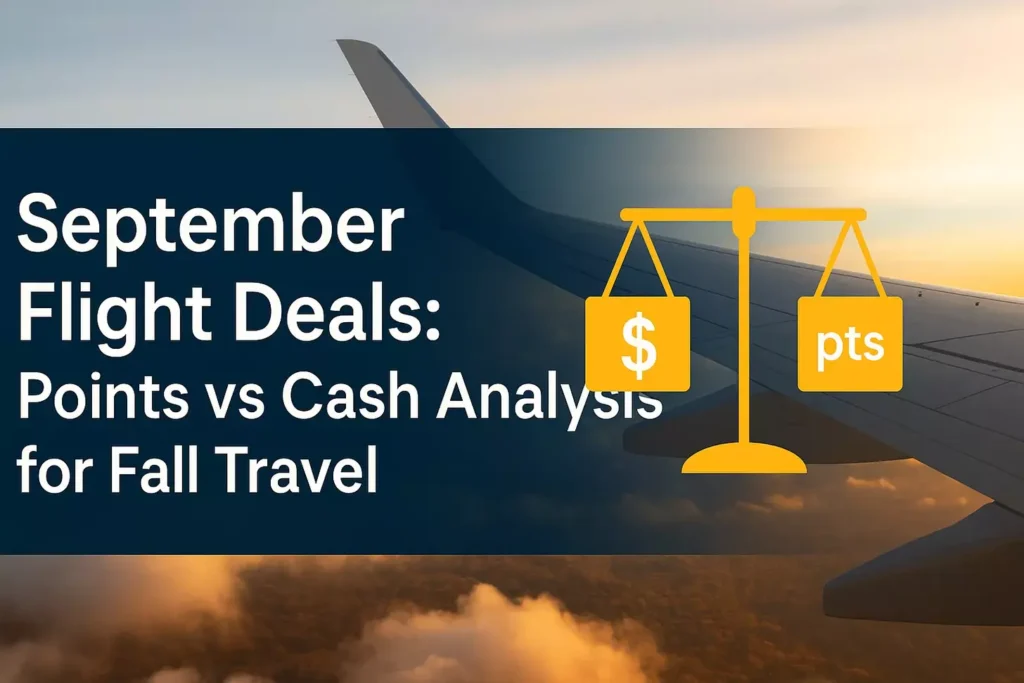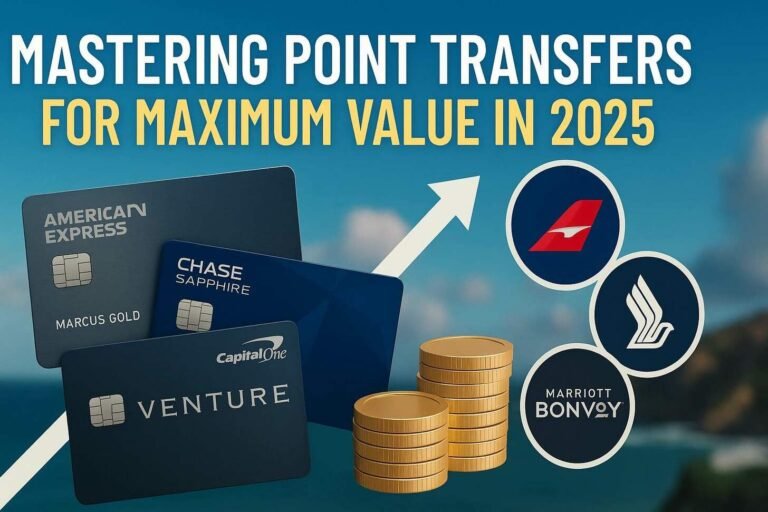Affiliate Disclosure: Award Travel Hub may earn a commission or referral bonus from some links on this site. These affiliate links help support our work and may influence the placement or promotion of certain products or services. However, our content is independently crafted to reflect honest opinions. Not all offers or products are included. There is no additional cost to users when they utilize our affiliate links.
Surprising fact: over 40% of last-minute domestic tickets end up cheaper to buy with cash than to redeem with points or miles at the time of booking.
We set the stage with a real example: a last-minute Delta seat lists at $450 or 30,000 miles + $40 in fees. Using a miles-to-dollars calculator makes that comparison simple and transparent. The calculator makes that comparison simple and transparent.
We explain how to convert rewards into a standard metric, factor in fees and lost earnings, and decide when to pay cash or redeem an award. Experts warn about devaluation, so many of us tend to use miles sooner rather than later.
Throughout, we highlight tools and a mindset: optimize for your trip goals, watch for dynamic pricing, and use credit card transfer partners when it helps stretch your rewards.
Key Takeaways
- Convert fares into dollars per mile to easily compare options.
- Cheap cash fares can often beat redemption rates; check both before booking.
- Fast decisions matter—award space and prices shift in shoulder season.
- Protect your rewards: account for devaluation when choosing redemptions.
- Use credit transfer partners and calculators to boost overall value.
Why September Flight Deals Matter for Fall Travel Buyers
Booking behavior changes after peak season, and that alters both cash and award pricing. We examine how seasonal shifts create buying windows and when it’s smart to use rewards versus paying cash.

Seasonal price patterns heading into fall
As summer ends, demand softens on many routes. Weekday fares often drop while weekends—especially leaf-peeping periods—stay competitive.
How shifting demand impacts fares and award rates
Airlines adjust inventory and award rates using booking curves, route competition, and school calendars. Dynamic award pricing can track cash fares closely, while some programs still rely on fixed charts.
- Shoulder-season trend: weekday cash fares fall on less-traveled routes.
- Program variety: many airlines use dynamic pricing; others offer chart stability that can outshine volatile fares.
- Route differences: short-haul business travel can lift weekday flight prices; transatlantic leisure demand often eases.
- Timing and extras: fuel surcharges, airport taxes, and mid-week price drops affect final choices and credit-card purchases.
“Watch load factors and award inventories—opportunity often appears in small windows when demand shifts.”
We recommend monitoring both cash and award options on target dates. Use simple comparisons of dollar fare versus cents-per-mile to find clear winners.
Points vs Cash: The Buyer’s Guide Framework for This September
Start by deciding what this trip must deliver: lower out-of-pocket cost or rare premium cabin access. That clear objective makes every booking choice simpler and helps measure real value.

Define your trip goal: save dollars vs unlock premium value
We ask ourselves whether the main aim is to cut immediate expenses or to access a seat we could not otherwise afford. If cash and award totals are similar, save miles for a future high-value redemption. Miles can devalue, so holding indefinitely is not risk-free.
Match trip type to the best payment method
Short, cheap domestic economy often favors paying cash. Long-haul premium cabins usually justify redeeming points or miles. For families or groups, availability may push us toward cash even when cents-per-point looks attractive.
Consider flexibility, cancellation, and change rules
- Primary objective: pick saving cash today or capturing premium cabin value.
- Flexibility: award tickets sometimes allow easier changes; basic economy cash fares can be restrictive.
- Status and earnings: paying cash often earns credit and miles; award tickets usually do not.
- Practical tip: set trip-specific thresholds ahead of time to avoid on-the-spot stress.
“If cash and award values are close, conserve miles for a bigger win later.”
Calculate Value with CPM: Turn Fares into Cents-Per-Mile
A clear cents-per-mile score removes guessing and speeds booking decisions.
How CPM works and when it favors points
Use this formula: (Cash price – award taxes/fees) / miles required. That gives you CPM in cents.
Example: a $250 fare versus 25,000 miles + $11.20 in fees ≈ 1.0 CPM. If the cash amount rises to $500 for the same 25,000 miles, CPM ≈ 2.0. Higher CPM usually favors redeeming points.
Adjust for taxes, fees, and lost earnings
Always subtract the award taxes and surcharges before dividing. Some programs still add steep carrier surcharges that cut real value.
Remember: award redemptions rarely earn redeemable miles or elite credits. That foregone earning is an opportunity cost to include in your math.
Set cash benchmarks to avoid “points paralysis”
We recommend route-specific CPM targets. If an option doesn’t hit your target, pay dollars and save points for bigger wins.
- Quick tip: subtract fees, divide by miles, compare to your benchmark CPM.
- Use a calculator or extension to compute CPM in seconds.
- Let schedule and seat comfort trump CPM when values are close.
“CPM is a decision aid, not a rule—use it to act, not to overthink.”
Dynamic Pricing vs Award Charts: How Many Airlines Price Redemptions
Not all award pricing behaves the same; some programs mirror cash fares while others stay steady. We outline how each approach affects value and planning. This helps you decide when to redeem miles or conserve them.
When charted rates can win and why timing matters
Many airlines peg award levels to cash, so peak dates often cost more in miles. That dynamic model tracks demand and can spike quickly around holidays and at the last minute.
By contrast, chart-based program rules offer predictable rates. During both peak and off-peak periods, those charts can deliver consistent bargains on specific routes.
- Partner bookings: book through a partner program to access lower saver tiers even when the operating carrier charges more.
- Regional sweet spots: some routes consistently show chart advantages—watch those routes and lock in awards early.
- Booking time: check availability at different times; last-minute changes often alter value dramatically.
We recommend a blended strategy: monitor dynamic deals and chart availability. Before you redeem, verify the date hits the lowest award tier and compare the cents-per-mile equivalent. This simple check saves miles and keeps your options open when you plan travel.
When Cash Wins: September’s Cheap and Promo Fares
When airfares dip, paying out of pocket often provides the best immediate value and flexibility. We track routes where shoulder-season demand drives sub-$200 round-trips that are hard to beat with points or miles.
Promo sales and flash discounts can push CPM well below your target. That signals a clear way to buy cash and conserve rewards for bigger wins.
- Watch short domestic hops and busy trunk routes; they frequently show low cash rates.
- Flash fares often sink CPM so low that using miles offers poor comparative value.
- Basic-economy limits can be offset by elite perks or co-branded card benefits, making paid purchases more attractive.
- Stack portal rebates, statement credits, or targeted promos to lower net cost further.
Quick decision rule: if the out-of-pocket price undercuts your CPM goal and flexibility needs are met, buy cash and save miles.
“Factor accrual from paid flights — earnings and status boosts improve the effective return on purchases.”
When Points Win: Luxury Cabins and High-Cash-Price Routes
High cash fares can turn ordinary rewards into exceptional trips. When a premium cabin costs thousands, using points and the right partners often yields far more value than paying out of pocket.
International business and first-class sweet spots
We target long-haul routes where a roundtrip business seat lists at four digits. In such cases, a partner program can offer a redemption that significantly reduces the required miles.
Look for partner charts and periodic award sales that drop mileage needs. Transfer timing matters—only move points when saver space shows.
Hotel redemptions when cash rates spike
Peak events can make nightly rates sky-high. Redeeming loyalty points at full-service hotels can easily beat the cash outlay and preserve your credit balances.
- Target: premium cabins where cash fares reach thousands and partner charts shine.
- Check: surcharges and choose partners that minimize fees.
- Plan: time transfers, use positioning flights, and open-jaw routing to stretch points miles.
- Enjoy: lie-flat seats, lounges, and superior service that transform the trip experience.
“Redeem smart: protect schedules and fees while chasing outsized experiential returns.”
Short Domestic Hops: Think Twice Before Spending Miles
On routes under three hours, a simple CPM check can save you miles for bigger wins.
Short-haul fares often price cheaply in cash, so award redemptions frequently return sub-1.2 CPM. That low cents-per-mile outcome makes redemptions a poor use of limited currency.
Exceptions exist. Last-minute bookings, holidays, or sold-out paid seats can flip the math and make an award compelling.
- Remember opportunity cost: spending two small redemption seats may cost a premium international flight later.
- Baggage, seat selection, and change policies change the equation; paid fares sometimes include perks that matter.
- Track flash sales and use card-linked benefits or credit protections on paid purchases to boost net value.
“Save miles where cash wins, and use awards when the cents-per-mile tells a clear advantage.”
Our way: set a simple cash threshold for short hops. If the fare sits below it, pay cash and protect your redeemable points and miles for true high-value trips and better overall value in future travel. Airlines reward flexibility; use that to your advantage.
Last-Minute September Flights: Saver Space vs Sky-High Cash
Close-in redemption availability can flip the math, making miles more valuable than steep last-minute fares.
Why award space can open close to departure
Airlines release saver award inventory when revenue seats are not selling. That helps carriers fill cabins and salvage revenue.
We watch those windows because cash rates often climb as departure nears. That divergence creates clear opportunities.
Premium-cabin opportunities on short notice
Premium seats sometimes show saver award space days before travel. Transferable currencies allow us to move miles or points instantly and book quickly.
- Set alerts and keep flexible dates to pounce.
- Watch programs that avoid steep close-in booking fees or offer modest credit protections.
- Repositioning to a nearby hub can widen options quickly.
- Decide fast: award space often disappears within hours.
| Option | Booking Horizon | Value | Consideration |
|---|---|---|---|
| Last-minute award | 0–7 days | High when cash spikes | Transferable balances needed |
| Buy via portal with points | 0–30 days | Flexible but may earn miles | Check portal rates vs award |
| Paid last-minute | 0–7 days | Often costly | May earn elite credits |
“When cash fares surge, last-minute saver awards can be the best path to premium cabins.”
Peak and Off-Peak Strategy for Fall Travel
Identifying off-peak windows lets us stretch our rewards while avoiding dynamic spikes. We target calendars and program rules to maximize booking flexibility and get more value from each mile and point.
What to watch:
- Chart-based programs that publish off-peak award bands—these often show lower rates during shoulder dates.
- Hotel category shifts in the low season that deliver excellent nightly value on points.
- Airlines that still use fixed charts can protect you from volatile dynamic pricing.
Align dates with off-peak calendars, scout secondary airports, and favor midweek departures. Stack transfer bonuses and limited award sales to stretch miles further. When cash purchases make sense, factor in credit benefits and earnback on paid fares.
Flexible-date routine: run a seven-day search window, set alerts for calendar updates, and move transferable balances only when saver space appears.
| Strategy | When to Use | Benefit |
|---|---|---|
| Book off-peak award | Shoulder season dates | Lower miles needed, predictable rates |
| Stack transfer bonus | During partner promotions | Stretch points and reduce net cost |
| Choose midweek / secondary airport | Flexible schedules | Access lower award tiers and fares |
“Use program calendars to lock value before dynamic pricing catches up.”
Fees, Surcharges, and the Real Cost of an Award
Hidden cash components can turn a bargain award into an expensive purchase in minutes.
Many award tickets carry carrier-imposed surcharges, airport taxes, and other mandatory cash line items.
These extras reduce your effective CPM and shift the true amount you pay.
What we check:
- Typical taxes, airport fees, and fuel surcharges vary by partner and route.
- How do the out-of-pocket dollars compare when booking through different programs?
- Ways to test alternate origins or connections to lower surcharges.
We also factor in baggage and seat charges that you might avoid with elite status or the right card.
That hidden cost can turn a low-mileage redemption into a mirage.
| Option | Out-of-Pocket | Miles Required | Effective CPM (¢) |
|---|---|---|---|
| Direct airline award | $220 | 25,000 | 0.79 |
| Partner booking (lower surcharge) | $45 | 30,000 | 0.13 |
| Cash purchase with statement credit | $260 | — | — |
Quick rule: always recalculate CPM after adding every cash line item before you transfer or book.
“Include taxes and surcharges in your math — the headline mileage rarely tells the whole story.”
Use our checklist before finalizing: total out-of-pocket dollars, miles required, baggage and seat fees, and whether a card benefit reduces the effective amount.
Status Goals and Double-Dipping Strategies
Elite targets often change how we book late in the year. When requalification is close, a paid fare can be the fastest path to status.
Airlines rarely count award bookings toward elite tiers, but paid tickets do. If a few qualifying segments or dollars separate you from re-up, buy the ticket and secure those credits.
Redeeming flexible miles for statement credits while earning
Some programs let you redeem flexible points as a statement credit at fixed rates. Capital One, for example, offers redemptions that offset purchases while allowing you still earn miles on the original booking if you pay out of pocket first.
- Prioritize cash on fares that yield the most elite credits.
- Use flexible currency to offset costs afterward when cents-per-mile is fair.
- Check which hotel program counts award nights toward status before redeeming.
| Situation | Action | Why |
|---|---|---|
| Close to requalify | Pay cash | Secures elite credits and perks |
| Need to reduce outlay | Buy then redeem flexible points | Double-dip: earn and offset |
| Hotel with counted award nights | Redeem awards | Keep status progress |
“Paying for the right fares now can pay dividends in benefits later.”
Tools That Decide for You: Calculators and Extensions
A few reliable apps can turn a long comparison into a single click. We use tools to compare cash, award costs, and hidden fees so our booking choices stay fast and smart.
Airline miles-to-dollars calculators
The core is a simple miles-to-dollars calculator. Input the fare, award price, and fees and get an instant CPM figure.
Why it helps: It removes guesswork and shows when airline miles or cash wins.
Browser extensions that surface award options
Extensions like Points Path overlay award prices on standard flight searches. They support multiple partners and link straight to award booking pages.
Result: you see cash and award choices side by side and save minutes on every search.
Track expirations so value never expires
Use AwardWallet or MaxRewards to monitor balances and set alerts. That prevents losing points and keeps our strategy active.
- Use a calculator to compute CPM before transfer or booking.
- Enable extension overlays to compare cash, awards, and portal pricing at once.
- Store typical CPM targets in the tool and enable expiration alerts.
- Check partners and terms to avoid steep surcharges.
“Tools speed decisions; good workflows protect both savings and flexibility.”
Credit Card Ecosystem: Chase Sapphire Preferred, Capital One, American Express
Credit cards shape how we convert everyday spending into premium award opportunities. The three major ecosystems each offer different transfer networks, portal options, and perks that matter when deciding whether to move balances or hold them.
Transfer partners and booking options across programs
We map key transferable ecosystems and how partners amplify award options on airline and hotel redemptions.
- Chase (including Chase Sapphire Preferred and Sapphire Preferred) links to many airline and hotel partners for high-value transfers.
- Capital One partners with several international carriers and select hotels, which can be useful when miles are scarce.
- American Express has a broad partner reach, but terms apply to some benefits and transfer rates.
Earning structures that align with fall purchases
We break down fall spending categories—dining, groceries, gas—and how bonus categories accelerate points. Pair an entry-level card with a premium card to cover daily purchases and big buys.
Terms, responsible use, and best practices
Transfer bonuses can tip the scales toward immediate redemptions. Always check program rules before you transfer, confirm award space, and read the fine print.
“Use transfers only after you verify award availability; otherwise points move but seats may not.”
| Issuer | Best use | Notes |
|---|---|---|
| Chase | Flexible airline and hotel transfers | Good combo with sapphire products |
| Capital One | Broad airline partners | Great when direct miles are lacking |
| American Express | Premium partner awards | Check benefits and terms apply |
Final tip: combine household balances where allowed, protect accounts with alerts, and avoid negating rewards by carrying revolving credit. Responsible use keeps the math on our side.
September Flight Deals: Points vs Cash Analysis for Fall Travel
Real-case scenarios help us see when to conserve rewards and when to spend them without regret.
Quick domestic and international comparisons
Example 1: A last-minute domestic option lists at $450 or 30,000 miles + $40 fees. Using CPM, we compute: (450 – 40) / 30,000 ≈ 1.37¢. That rate helps us determine whether redeeming miles is a good idea.
Example 2: An international economy fare shows dynamic cash pricing at $1,200. A partner-chart award asks 60,000 points. After fees and lost earnings, the partner route can get value and preserve better future options.
When to “earn and burn” vs save miles
We prefer the earn-and-burn path when devaluation risks are present and the cents-per-mile advantage is minimal. Saving miles is smarter when a premium redemption would deliver outsized experiential value.
- Premium cabin: miles often unlock business at a fraction of the cash cost.
- Hotel during an event: redemptions can beat inflated nightly rates.
- Always include fees, surcharges, and lost elite earnings in your math.
| Scenario | Cash | Miles/Points | Decision Driver |
|---|---|---|---|
| Last-minute domestic | $450 | 30,000 + $40 fees | CPM ≈1.37¢ — lean cash unless schedule is inflexible |
| International economy | $1,200 | 60,000 + low fees | Partner chart often wins when fees are low |
| Premium cabin | $3,200 | 90,000 + moderate fees | Miles unlock outsized value — redeem |
| Hotel during event | $350/night | 20,000 points/night | Redeem if net cost per night exceeds your cash threshold |
Checklist: confirm award space, recalc CPM after fees, account for lost airline miles earnings, and verify credit-card protections on purchases.
“Use calculators and award search tools to turn examples into quick booking decisions.”
Booking Tactics to Get Value: Partners, Portals, and Transfers
A practical booking routine—search, verify, then transfer—keeps your miles working for you.
Finding saver-level space and lowest mileage rates
Search broadly across dates and nearby airports to spot saver award inventory. Use calendar views and mixed-cabin options to reduce total rates.
Confirm you are seeing the lowest tier before committing. Some programs run Promo Rewards with deep discounts—wait for those when possible.
When to book via airline vs credit card travel portal
Booking directly with an airline can unlock true saver awards and partner routing that portals may hide.
Portals offer rewards on purchases and typically earn miles and status. Choose the portal when earning and protections matter more than the lowest award price.
Timing transfers and watching for award sales
Never transfer until you find confirmed availability. Transfers are often irreversible and can waste flexible currency.
Set alerts for transfer bonuses and limited-time award sales. A modest bonus can swing the math and improve redemption value.
Avoiding fuel surcharges with partner choices
Pick partners whose routings or interline rules keep surcharges low. That simple choice often trims out-of-pocket fees on long-haul trips.
- Search partner availability before transferring balances.
- Test alternate routings and nearby airports to cut total outlay.
- Use calendar tools and alerts to catch short promo windows.
“Search first, verify rates and award space, then transfer—it’s the fastest way to lock in clear value.”
Conclusion
Use measured thresholds to protect rewards while seizing high-value redemptions. We recommend a simple playbook: pay cash when fares are cheap and flexible, redeem miles when cents-per-mile is compelling—especially on premium cabins and routes with steep cash rates.
Always run the full-cost math: add fees, surcharges, and lost airline earnings before you transfer or book. When status matters, prefer paid purchases to lock qualifying credits, then consider flexible redemptions to offset costs.
Leverage calculators, browser extensions, and expiration trackers. Pair tools with the right credit card ecosystem—Chase (including Chase Sapphire Preferred), American Express, or Capital One—to unlock partner sweet spots and benefits while acting responsibly.
Set thresholds, move fast, and book the trips that matter most. Apply this framework to your calendar and lock in value before pricing shifts.






